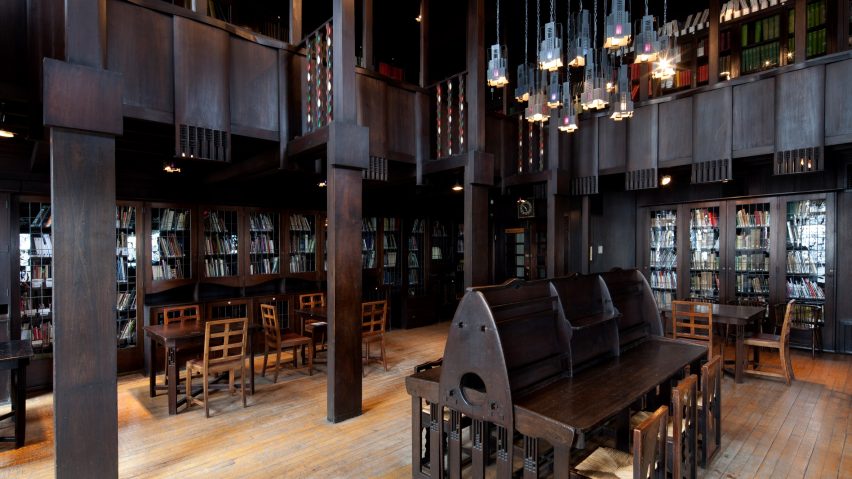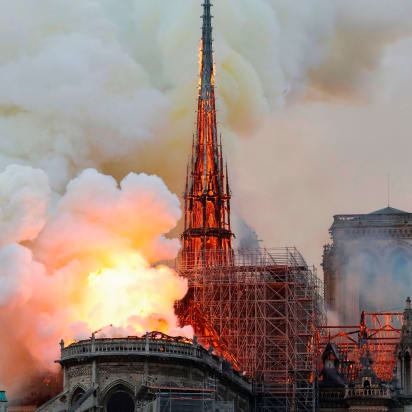Hello Everyone:
It is a very lovely Wednesday afternoon and Yours Truly is still in a very good mood. The Blogger Candidate Forum will be back at its regular Wednesday time, barring any major breaking story. Today, we are going to have a look at the restoration efforts of the Mackintosh Library in Glasgow, Scotland to see what can be applied to the task of restoring the Cathedral Notre-Dame in Paris.
The devastating fire at Cathedral Notre-Dame had Blogger thinking about the Mackintosh Library at the Glasgow School of Art. The library was designed by Charles Rennie Mackintosh in 1909 (gsa.ac.uk; date accessed Apr. 24, 2019). The library is an iconic example of the Art Nouveau. In 2014, a small fire destroyed parts of the building. Restoration on the affected parts were near completion when another, larger blaze burned the roof and upper floors (theguardian.com; June 16, 2018; date accessed Apr. 24, 2019). School officials vowed to rebuild, adding that construction could take up to a decade. In light of the fire at Notre-Dame, it is worth a look at restoration efforts see what we can learn.
 |
| MacKintosh Library interior Charles Rennie MacKintosh Glasgow, Scotland dezeen.com |
By all accounts, June 15, 2018 should have been a celebratory day for GSA: The pomp and circumstance of graduation and the 150th anniversary of hometown legendary architect Charles Rennie Mackintosh. The fire burned all traces of the restoration work that resulted from the 2014 fire. The school and architect are intimately connect because he was not only an alumnus but also the designer of the library. By the time the last of the burning embers were put out, his "masterwork" (dezeen.com; June 5, 2018; date accessed Apr. 2019), the library was barely a shadow of its former self.
| Damaged interior of Notre-Dame Paris, France sfgate.com |
Preservation focuses on the maintenance and repair of existing historic materials and retention of a property's form as it has evolved over time.
Rehabilitation acknowledges the need to alter or add to a historic property to meet continuing or changing uses while retaining the property's historic character.
Restoration depicts a property at a particular period of time in its history, while removing evidence of other periods.
Reconstruction re-creates vanished or non-surviving portions of a property for interpretative purposes (nps.gov; date accessed Apr. 24, 2019)
| Damage from the Mackintosh library fire architectsjournal.co.uk |
The Glasgow School of Art announce in the Herald Scotland that it plans to restore the library will be "entirely restored 'as Mackintosh designed it, to the millimeter'" (archpaper.com; Sept. 18, 2018; date accessed Apr. 24, 2019). Restoring the library means returning it to its exact period of significance--the early 20th century--requiring extensive research not only into its design history but also methods of construction. This may be an easier task than restoring Notre-Dame because the library building is not overlaid with centuries of construction. However, restoration brings with it concerns of replication and concerns that it could become a museum piece. This sentiment was voiced by Glasgow-based alumnus, architect Alan Dunlop,
From what I've see, restoration is not an option,... We'd be talking about replication, which is totally against what Mackintosh stood for. He was an innovator, working at the cutting edge. He would
want to see a new school of art fit for the 21st century. (theguardian.com; June 19, 2018)
Roger Billcliffe (billcliffegallery.com; date accessed Apr. 24, 2019), the author of a series of definitive books on Charles Rennie Mackintosh told The Guardian,
I see no argument for why you wouldn't rebuild the school of art as it was,... It has been voted Britain's most important building several times over, and we have all the information needed to recreate every detail, following extensive laser surveys after the first fire. People are saying, 'Let's get a good modern architect instead,' but we've already had one in theory, and we got that Steven Holl monstrosity across the road. (Ibid)
Mr. Billcliffe argues that, "Despite Mackintosh's meticulous details and sophisticated spatial sequences,..., the school of art would be difficult to rebuild" (Ibid). Most of the conservation analysis has already been done and the replacement woodwork had not been installed at the time of the fire (Ibid).
 |
| The spire of Cathedral Notre-Dame Viollet-le-Duc (c. 1859) cnn.com |
As of right now, no decisions have been made regarding whether to preserve, rehabilitate, restore, or reconstruct. No one has been allowed to go in--for obvious safety reasons--to do an architectural assessment. Further, Notre-Dame has about 850-years worth of architecture and decoration so deciding which period to bring it back to is going to require extensive research and laser surveys. UCLA associate professor of medieval art and architecture Meredith Cohen (washingtontonpost.com; Apr. 19, 2019; date accessed Apr. 24, 2019) has some ideas on how to restore Notre Dame without falsifying history. What happens once the debris is cleared and a proper assessment is done?
The first step is arresting further degradation. Prof. Cohen writes,
The building was already undergoing urgent conservation, because of the interventions of 19th-century restorers Eugene-Emmanuel Viollet-le-Duc and Jean-Baptiste Lassus--including the spire they rebuilt--were causing damage (Ibid)
The 19th-century restorers replaced the stones in the walls and on the flying buttresses, which were eroding at a faster pace than the 12th-century stones they left in place. In short, Notre-Dame absolutely has to be stabilized against any and all further degradation and a new roof will be necessary so that the stone vaults that cover the nave will no longer be exposed to the elements (Ibid).
Next, once this basic and essential work underway, thoughts regarding replacing the 19th-century spire should be expressed. The monumental restoration task France is about to undertake raises questions of what to preserve. Interesting fact, the spire that so dramatically collapsed is
dated to 1859 and replaced a 13th-century spire that was dismantled in 1786. It was not a copy of the medieval spire, for which there are no extant plans. Rather, this neo-Gothic fantasy's artistic merit lay in its conveyance of 19th-century values concerning the unified French nation based on a rationalized form of medieval architecture (Ibid).
The spire can be reproduced today, but should it? Reproduction brings to mind the specter of Disney-fication, something that Scottish architect Alan Dunlop fears could happen to the Mackintosh Library. Which of the nearly nine centuries should take precedence? What should be done with the fact that most of the original building was lost during the French Revolution? Do you return the cathedral to its pre-revolutionary state? Remove the electric lights? You see that all these questions can lead down a rabbit hole in which architects, planners, concerned parties, and government officials spend years deciding what do. Fortunately, there is a guide.
The 1964 Venice Charter (icomos.org; date accessed Apr. 24, 2019) published by the International Council on Monuments and Sites, laid out a set of guideline for conservation and restoration, declaring,
The intention in conserving and restoring monuments is to safeguard them no less as works of art than historical evidence...Replacements of missing parts must integrate harmoniously with the whole, but at the same time must be distinguishable from the original so that restoration does not falsify the artist or historic evidence (washingtonpost.com; Apr. 19, 2019).
Therefore, if the spire is to replaced, then why not hold a global design competition to create a spire that respects the period style of Notre-Dame while acknowledging the present? It may sound a little insane but it could offer a sense of transparency and greater value to each and every period style housed within the cathedral's walls.
Complicating the extensive restoration is the fact that it is a functioning monument that requires constant upkeep, even under normal circumstances. It is a major tourist site, holds regular services, and is an integral part of the French cultural patrimony. One of the tasks before the architects is reconciling all of these functions in a way that allows a church goer to attend services without disruption from a selfie-taking tourist. Easier said than done. The climate is another major challenge; the heat and humidity generate from the crowds is definitely not good for the building and its structure.
Both the Mackintosh Library and the Cathedral of Notre-Dame are iconic monuments to their period. Notre-Dame is an extant example of a building built continuously in the Gothic manner between the 12th-and 14th-centuries. The library is a prime example of early 20th-century cutting edge architecture. Fortunately, there is plenty of funding available to restore, preserve, rehabilitate, and reconstruct them. The debate centered around whether to restore the Mackintosh Library or demolish it is a microcosm of the debate facing the French. Yours Truly can say without contradiction that no will ever insist on demolishing the cathedral but perhaps it might be best to follow the Japanese example of preservation: demolish and rebuild as in the ritual reconstruction at Ise Shrine. We will see what the future holds.
No comments:
Post a Comment